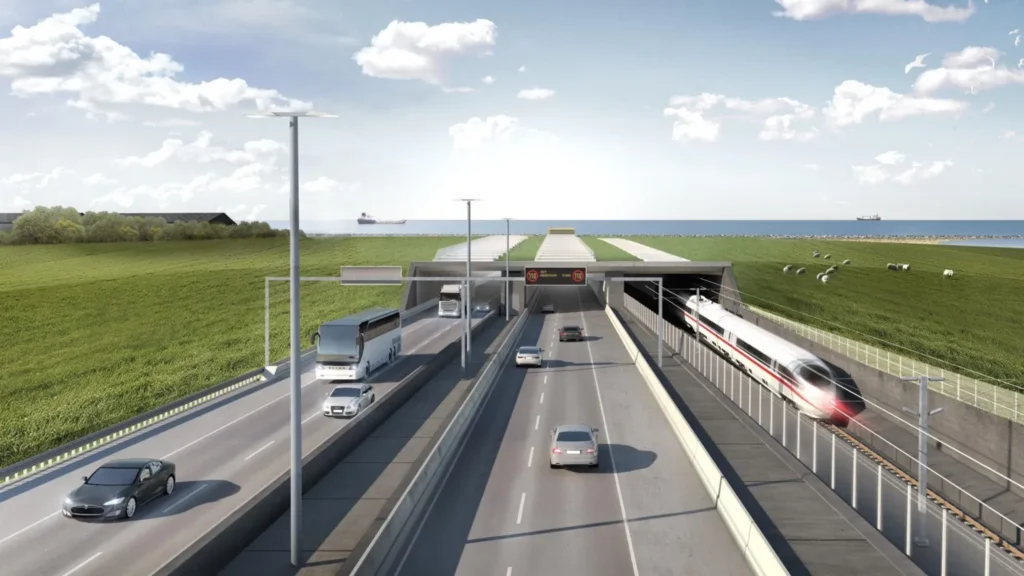LOLLAND, Denmark — A massive infrastructure project is reshaping connectivity between Scandinavia and mainland Europe as construction progresses on the Fehmarnbelt Tunnel — set to become the world’s longest immersed road and rail tunnel once completed beneath the Baltic Sea.

Stretching 18 kilometers (11 miles) between Rødbyhavn in southern Denmark and Puttgarden in northern Germany, the Fehmarnbelt Fixed Link will dramatically slash travel times and offer a faster, greener alternative to ferry services, while also representing a landmark achievement in civil engineering.
Built using pre-fabricated tunnel sections, the structure is being assembled segment-by-segment directly on the seafloor. The project, which began major construction in 2020, is scheduled to open in 2029.
“This is a huge undertaking,” said Henrik Vincentsen, CEO of Femern A/S, the Danish state-owned company leading the project. “We’re breaking records with this tunnel. Immersed tunnels have been built before, but never on this scale.”
Unlike most underwater tunnels that bore through bedrock, the Fehmarnbelt will consist of 90 massive tunnel segments — each 217 meters long and 42 meters wide — that are cast in reinforced concrete and then floated out to sea from a nearby construction harbor before being lowered into a seabed trench.
Each segment weighs more than 73,000 tonnes and is equipped with ballast tanks and watertight seals to ensure they are safely maneuvered and precisely aligned using GPS and underwater cameras.
“This is not just about construction,” said senior construction manager Anders Gert Wede, walking through one of the hollow segments on the Danish side. “It’s about millimeter-level precision — we’re aligning these 40 meters below sea level with only 15mm of tolerance.”
The tunnel includes five tubes: two for road traffic (each with two lanes), two for trains, and one for emergencies and maintenance.
The total project cost is estimated at €7.4 billion ($8.1 billion), with the vast majority financed by Denmark and €1.3 billion contributed by the European Commission as part of the EU’s broader infrastructure initiative to reduce carbon emissions and improve connectivity across the continent.
Once operational, the tunnel will cut car travel between Denmark and Germany from 45 minutes by ferry to just 10 minutes. Rail travel between Copenhagen and Hamburg will be halved — from five hours to 2.5 — enhancing both passenger and freight transport routes across Europe.
“This is more than a tunnel,” said Vincentsen. “It’s a direct corridor linking Scandinavia to the heart of Europe. Everybody wins — from commuters to the climate.”
The project faced strong resistance in Germany, where ferry operators and environmental groups, including NABU (Nature and Biodiversity Conservation Union), challenged the plan, citing risks to local marine life like harbor porpoises. However, in 2020, a German federal court ruled in favor of construction, allowing the project to proceed.
In response to environmental concerns, developers created a 300-hectare wetland and recreation area using materials dredged from the seabed, part of a larger effort to mitigate ecological disruption.
“We’ve done extensive work to minimize environmental impact,” Vincentsen said. “This tunnel is designed not just for speed and access, but for sustainability.”
The Fehmarnbelt project is also expected to revitalize the economy of Denmark’s Lolland region, one of the country’s most impoverished areas. The tunnel site — covering 500 hectares — includes Europe’s largest construction harbor and a specialized factory producing the tunnel elements.
“The locals have waited decades for this,” said Wede, a native of the region. “This project is bringing jobs, infrastructure, and new opportunities for business and tourism.”
More than 12,000 vehicles and 100 trains are expected to use the tunnel daily. Toll revenues will be used to repay the state-backed construction loans over approximately 40 years.
“Ultimately, the users will pay for the tunnel,” Vincentsen said. “But the benefits — economic, environmental, and social — will last for generations.”
bbc.com



